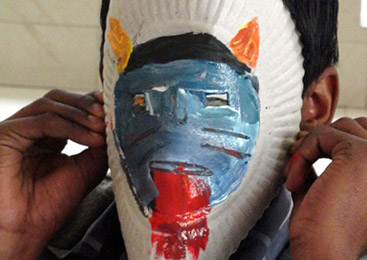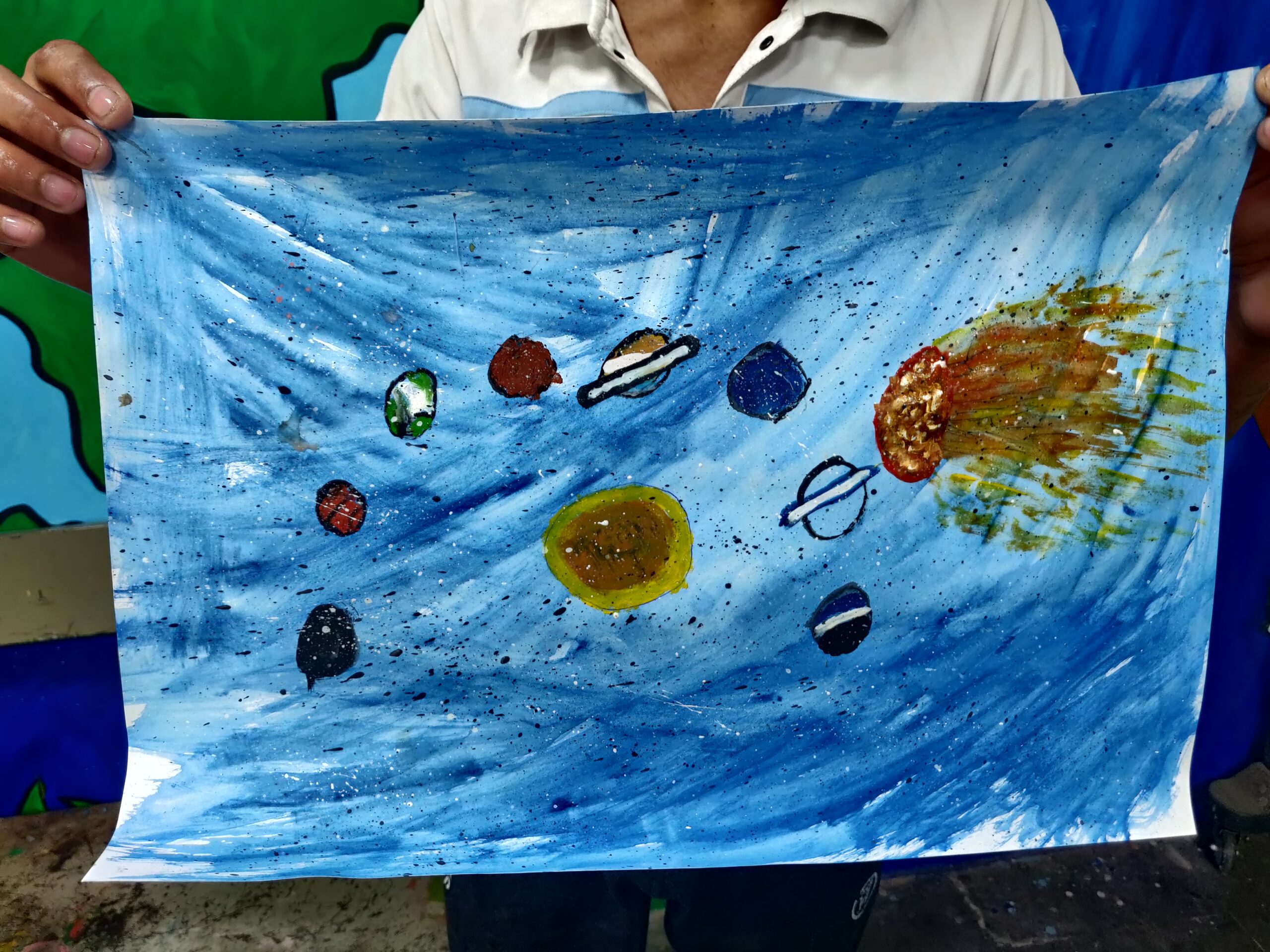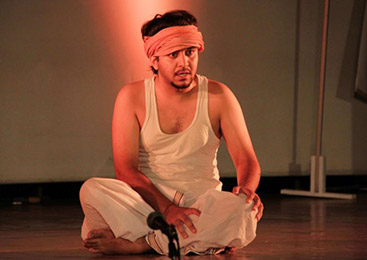My introduction to Papier Theatre – and how I Survived!
02-Dec-2018Raju, Matia, Sonu… unforgettable characters spring forth from the pages of Shyamal Kumar Pramanik’s short story “Survival”, to share their gnawing hunger and degrading struggle to survive. Not an unfamiliar “Dalit” story. Yet they come home with me every night. I have signed up for a Papier Theatre workshop for 3 weeks mid March, not actually being a puppeteer! From making documentaries, corporate films and Television programs for 20 years, I had gone back to my first love Theatre and was enjoying exploring its power as a tool to communicate and empower. At the core of it all was the consuming fire of storytelling, and as I realized, the greater the skill of the teller, the more magical the story. “Alain Lecucq and Nargis Majd are Master Puppeteers, who will be focusing on the dramaturgy of the story, on the “What”, “Why” and “to Whom” you want to communicate with. You would enjoy it”. Anurupa’s words have me hooked! I send in my application, get an acceptance and for the next 3 weeks, starting 14th March, I jump into my car at 8am and zip down the highway from Gurgaon, to make it on time for the 9:30 workshops at the Crafts Museum. This means no morning walks or exercise but such is my enthusiasm, that everything else is put on hold for 3 weeks. Of course I will pay the price of excruciating cervical pain once we go back to our “normal” lives, but I am so much richer for the experience! It is an enchanting 3 weeks of stepping into a fairy tale world of make believe and watching it come alive! Starting with making simple paper stages and stories from personal experiences, we are exposed to some mind boggling videos of shows that Alain has done as well some of the most creative and innovative ones from across the world. I remember crawling back to the workshop space feeling most disheartened and almost embarrassed about what we had presented on the first day. The Bar of Excellence has suddenly gone so high, we have not even made our first baby steps! Alain and Nargis are amazing as they alternate between being teachers, parents, guides and friends, adding to the warm bonhomie that has developed within the group. Starting with 11 participants, 9 of us complete the course, exploring 4 different stories through completely different formats. My team mate Binitesh and me choose to work on Pramanik’s story “Survival”and spend the first few days diving deep into the themes and sub themes that the story opens up for us. Out of the 5 to 6 strands that seem to flow through the story, we have to crystallise our thoughts to choose one Central idea that will be our touchstone for all the creatives thereafter. Wading through the complexities the story throws up for each one of us, we struggle to define that simple connecting thread, little realizing how important this will be, in keeping our entire presentation true to our central theme. As I put pencil to paper and start allowing the story to flow into the storyboard, it comes alive in a way I have not experienced before – so simply and so quickly. I am Raju, fighting against the bitter cold, to feed and protect my wife and son – Matia and Sonu. It is my mother who has died an excruciating death while my father watches helpless in the famine, and I am determined this will not be the fate of my child. Bini and me discuss, argue, agree, work together, reflect individually, share our thoughts and arrive at a consensus most times. It is fascinating to see a baby being crafted by two completely different individuals, drawn to a common theme, and to see it evolve from paper sketches into human characters as we draw and colour and fix them to cardboard sliders with “spines” glued to their backs. Our little wooden stage is built by a carpenter simultaneously and as backdrop after backdrop slides into its slot on our stage, the characters or “paper puppets” glide on to share their tale of desperation and sheer grit to stay alive. At our final presentation at the India International Center, we add the magic of sound effects and focussed lighting and I am told that the effect is quite mesmerising. “Where would we be taking this show from here” is a question I am asked by many members of the audience. Yes, where indeed would I be taking the show? Bini has gone back to Mumbai to teaching at his Film Institute, but I do have Raju and Matia and Sonu with me, who sit in my office room and look at me questioningly everyday! I owe it to them, to Alain and Nargis, to Ranjana and Anurupa, to our wonderful group who worked together and to Bini and me, to keep them alive and introduce them to all those out there who want to receive them. Ah, the forest beckons and I promise we shall all walk through it again – soon! – Puneeta Roy- Managing Trustee, The Yuva Ekta Foundation
MORE ARTICLE FROM OUR BLOG

Volunteer’s Diary- Sahyog
Entering the gates of Sahyog campus triggered a series of emotions in me. Was it anxiety or fear or anger or compassion or curiosity? I don’t know! I entered the campus with an empty mind. I tried not to have any presumed notions about these juvenile offenders. The term ‘juvenile’ is used for person below the age of 18, accused in any crime. Having worked with children before, I believe these children were a little different. However, they were and they did behave like any other child of their age group would have.
Freud’s Psychoanalytic theory suggests that personality is mostly established by the age of five. Early experiences play a large role in personality development and continue to influence behaviour later in life. If these psychosexual stages are completed successfully, the result is a healthy personality. If certain issues are not resolved at the appropriate stage, fixation can occur. Perhaps, this issue makes them different from other children. Dysfunctional family, certain incidents, addiction, poverty, illiteracy, lack of guidance affects them.
Consequently, I was there to grasp and learn all I could, therefore I did not want to talk or do anything. I did not want to interrupt their activities. I just wanted to observe. Observe their actions, reactions.
I was amazed to learn how they had perceived of me as their ‘female’ volunteer, my clothes and my gestures. I was shot at with vulgar comments momentarily. They excelled at playing and twisting my words, so as to change its meaning completely. To their surprise, I was good at dodging them. With my presence, I was determined to bridge the gap. Their constant gaze at me confirmed the urgency of the same. We shook hands, talked, and laughed.
We started with the workshop, with over 30 boys. We worked on painting and decorating matchboxes.
I was happy to see the positive reaction towards the workshop. I took as a sign of acceptance. There were moments of vexation. However, my aim was to read into their minds, rather than sit back out of disappointment. Matchbox was just a medium. Whether they painted it or not, didn’t really matter. Small dusty hands, with chewed nails, scribbling black and white stripes, and then painted it all black, when almost a beautiful unpredictable design was going to come out. Some chose to keep quiet and observe, while some found it impossible to be quiet. I was amused to overhear a myriad of comments.
It was perhaps because of lack of interaction with the other sex. Their curiosity about the other sex is incomplete. Coming from dysfunctional families, the very idea of one’s mother, sister or a friend was still hazy. Most of them come from backgrounds where a casual friendly relation with the opposite sex is stigmatized. There was a tendency in them to emulate all ”film stars” and bollywood actors.
Bruise and cuts on their wrists and arms were enough for me to understand their extent of extreme feelings.
With my presence, I hope to abridge the gap between ‘us’ and ‘them’. They are disheartened and some have lost hope of coming back on track. I don’t want to be an idealist to them, but just wish to expose them to the normalcy of life, be it towards women, elders or law. Their expression in the form of art can be our path into their minds.
– Sanya is a Masters student who has been volunteering with us for a month. This is her feedback from her first session at SPYM Sahyog de addcition home.
READ MORE
Colours of Hope!
The workshop that me and Poorva had thought of did not have a structure. It stemmed from a simple idea: no structure, just boys, paper, and the freedom to let the brush guide them. The world that the boys live in is already structured and bound by rigid rules. Adding more structure would just mimic their daily routine. Imagination is limitless but while talking to the volunteers at the home I realized that imagination can be limited if one is never allowed to explore and think beyond one’s boundaries.
While talking to Puneeta there was a discussion on people who come from outside for workshops can be a sign of hope for the boys. I do not know how I can be a sign of hope at times because I struggle in my daily life to find hope in terms of my future, but maybe because I do not have any literal constraints such as the bars that surround the boys but only the constraints in my mind. Maybe because I can see the sky without any physical/material constraints and can draw the Sonipat skies without having to emphasize the jail bars in my painting. Maybe because for me freedom is easy and taken for granted.
When we started to distribute brushes and paint there was a sense of confusion as the boys had to make their own choice in selecting the brushes like they didn’t know what and how to choose. When we began to paint few of them just sat down and looked at the empty canvas and other the room to search for an inspiration or idea. Some were skeptical to even pick up the brush and start using watercolors because it was new, and no colors appealed to them. Black dominated the palettes of five or six boys. It resonated with me. Why black? What darkness did they find in that shade? Did it grant them the courage to explore other colors, or perhaps express the darkness within them? There I was, surrounded by black, starting my own piece with vibrant reds, pinks, and greens. Paradoxical? Two realities coexist. But slowly, their paintings transitioned from darker shades to a lot of blue, sceneries, and smiley faces in inanimate objects.
I don’t know if the workshop will be fruitful in the long run, but I do hope that their imaginations will not be bounded by constraints of the society and boys will be shackled by the darkness of their past. Like any other teenager, I can only wish for them to find their happiness in the realm of their imaginations if not anything else.
– Eshani Bora, Young India Fellow, Ashoka University
READ MORE
Sweet Reminiscence
What does it take to not forget something? Has it ever happened to you, that when you return from somewhere you have a difficult time adjusting at home? Withdrawal symptoms (as close as it could get) a plenty and you keep asking for more of the same experience. The only thing you think about for sometime is when, where and how you will get an opportunity to go back to the same place and experience something completely new? The true meaning of the term unforgettable is learnt. When you narrate stories of your journey, your mind leaves you gasping for more. Nostalgia, happiness, a weird feeling in the stomach, everything that makes you believe that this journey was special.
I don’t exactly remember when the process started and I certainly know it hasn’t ended. Once upon a time when we only thought we would be in Glasgow one day is now a time, existing, flowing, real and lived. We weren’t tourists (only), our intent was clear. That one hour in which we get to perform our play made the trip of ten days possible. ‘Shoonya se shikhar tak’ is therefore a landmark in my life. The intense training, workshops and preparations for this production has been growing experience. As an actor and as an individual, I have unmasked a lot within me. Shoonya se shikhar tak has not only made me realise the power of my dreams, but also my abilities to work on them. I can proudly say this intensity has made me lighter and stronger at the same time. The magical part is that i dont even know when this process started. It just seems smooth now that I look back on all these memories with fondness.
All of this however wasn’t limited to the one hour in the rotunda. But I think that this growth took a different course from there. Now that I think about it, I can’t find any words to describe my feelings the first time I stepped on the cushioned stage of the rotunda. The first time I ever tested my voice inside that dome, the first time I walked, crossed from one side to the other. Each movement of my body made me want to get that emotion more and more and made me never want to end this experience. And that one hour, when all our rehearsal time, our practise came to its actual test, the hour that made it all possible was an hour that I want to keep reliving. That one hour in which I was vulnerable, both emotionally and physically, on stage and especially off it is the hour I crave. As if that’s the kind of reality I want to keep living. Shoonya se shikhar tak has reached its first shikhar. I think it is time we take it forward, continue to work with ourselves and with this experience and make this journey limitless.
Its not so much about living a dream. It doesn’t hit you always that what you thought of once upon a time, is a reality you’re living. Its after you’re back, trying to adjust with your life that you realise that you just lived what you yearned for. I want to live it again. And keep living it.
For all this and more I would like to extend my heartfelt gratitude to everyone concerned and everyone who made this possible.
“Mere sapnon ka Yeh andaaz hai, ki har rang mein shaksiyat kuch khaas hai.
Mai kehta hoon Bohot ji li zindagi, Woh kehta ki abhi aur Jine ke aas hai.”
– Rijul Kataria works as a Research Coordinator with the Foundation. This blog was written as a part of the Tin Forest International Theatre Festival in 2014
READ MORE




